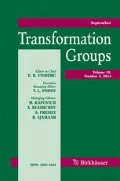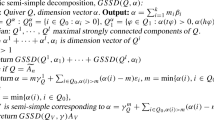Abstract
Let G be a linearly reductive group acting on a vector space V, and f a semi-invariant polynomial on V. In this paper we study systematically decompositions of the Bernstein–Sato polynomial of f in parallel with some representation-theoretic properties of the action of G on V. We provide a technique based on a multiplicity one property, that we use to compute the Bernstein–Sato polynomials of several classical invariants in an elementary fashion. Furthermore, we derive a “slice method” which shows that the decomposition of V as a representation of G can induce a decomposition of the Bernstein–Sato polynomial of f into a product of two Bernstein–Sato polynomials – that of an ideal and that of a semi-invariant of smaller degree. Using the slice method, we compute Bernstein–Sato polynomials for a large class of semi-invariants of quivers.
Similar content being viewed by others
References
R. Aragona, Semi-invariants of symmetric quivers of finite type, Algebr. Represent. Theory 16 (2013), no. 4, 1051–1083.
I. Assem, D. Simson, A. Skowroński, Elements of the Representation Theory of Associative Algebras, Vol. 1, Techniques of Representation Theory, London Mathematical Society Student Texts, Vol. 65, Cambridge University Press, Cambridge, 2006.
A. Borel, Linear Algebraic Groups, 2nd ed., Graduate Texts in Mathematics, Vol. 126, Springer-Verlag, New York, 1991.
N. Budur, M. Mustaţă, M. Saito, Bernstein–Sato polynomials for arbitrary varieties, Compos. Math. 142 (2006), no. 3, 779–797.
H. Derksen, J. Weyman, Semi-invariants of quivers and saturation for Littlewood–Richardson coefficients, J. Amer. Math. Soc. 13 (2000), 467–479.
H. Derksen, J. Weyman, Generalized quivers associated to reductive groups, Colloq. Math. 94 (2002), no. 2, 151–173.
H. Derksen, J. Weyman, On the canonical decomposition of quiver representations, Compos. Math. 133 (2002), 245–265.
H. Derksen, J. Weyman, Combinatorics of quiver representations, Ann. Inst. Fourier (Grenoble) 61 (2011), 1061–1131.
A. Gyoja, Theory of prehomogeneous vector spaces without regularity condition, Publ. RIMS 27 (1991), 861–922.
R. Howe, T. Umeda, The Capelli identity, the double commutant theorem, and multiplicity-free actions, Math. Ann. 290 (1991), 565–619.
M. Kashiwara, D-modules and Microlocal Calculus, Translations of Mathematical Monographs, Vol. 217, American Mathematical Society, Providence, RI, 2003.
T. Kimura, The b-functions and holonomy diagrams of irreducible regular prehomogeneous vector spaces, Nagoya Math. J. 85 (1982), 1–80.
T. Kimura, Introduction to Prehomogeneous Vector Spaces, Translations of Mathematical Monographs, Vol. 215, American Mathematical Society, Providence, RI, 2003.
J. M. Landsberg, L. Manivel, Series of Lie groups, Michigan Math. J. 52 (2004), no. 2, 453–479.
A. Lőrincz, C. Raicu, J. Weyman, U. Walther, Bernstein–Sato polynomials for maximal minors and sub-maximal Pfaffians, Adv. Math. 307 (2017), 224–252.
A. C. Lőrincz, Bernstein–Sato polynomials for quivers, http://opencommons.uconn.edu/dissertations/1111,Doctoral Dissertations 1111, PhD Thesis, 2016.
A. C. Lőrincz, Singularities of zero sets of semi-invariants for quivers, arXiv: 1509.04170v2 (2017), to appear in J. Commut. Algebra.
A. C. Lőrincz, The b-functions of semi-invariants of quivers, J. Algebra 482 (2017), 346–363.
A. C. Lőrincz, C. Raicu, J. Weyman, Equivariant \( \mathcal{D} \)-modules on binary cubic forms, Comm. Algebra (2019), DOI:https://doi.org/10.1080/00927872.2018.1492590.
G. D. Mostow, Fully reducible subgroups of algebraic groups, Amer. J. Math. 78 (1956), no. 1, 200–221.
V. L. Popov, E. B. Vinberg, Invariant theory, in: Algebraic Geometry IV, Encyclopaedia of Mathematical Sciences, Vol. 55, Springer-Verlag, Berlin, 1994, pp. 123–284.
C. Procesi, Lie Groups: An Approach Through Invariants and Representations, Universitext, Springer, New York, 2007.
C. Riedtmann, Explicit description of generic representations for quivers of type Anor Dn, J. Algebra 452 (2016), 474–486.
F. Sato, K. Sugiyama, Multiplicity one property and the decomposition of b-functions, Internat. J. Math. 17 (2006), 195–229.
M. Sato, Theory of prehomogeneous vector spaces (algebraic part), Nagoya Math. J. 120 (1990), 1–34.
M. Sato, M. Kashiwara, T. Kimura, T. Oshima, Micro-local analysis of prehomogeneous vector spaces, Invent. Math. 62 (1980), 117–179.
M. Sato, T. Kimura, A classiffication of irreducible prehomogeneous vector spaces and their relative invariants, Nagoya Math. J. 65 (1977), 1–155.
A. Schofield, Semi-invariants of quivers, J. London Math. Soc. 43 (1991), 385–395.
A. Schofield, M. Van den Bergh, Semi-invariants of quivers for arbitrary dimension vectors, Indag. Math. (N.S.) 12 (2001), 125–138.
D. A. Shmelkin, Locally semi-simple representations of quivers, Transform. Groups 12 (2007), 153–173.
K. Sugiyama, b-Functions associated with quivers of type A, Transform. Groups 16 (2011), 1183–1222.
K. Ukai, b-Functions of prehomogeneous vector spaces of Dynkin–Kostant type for exceptional groups, Compos. Math. 135 (2003), 49–101.
A. Wachi, Contravariant forms on generalized Verma modules and b-functions, Hiroshima Math. J. 29 (1999), 193–225.
R. Walters, The Bernstein–Sato b-function of the space of cyclic pairs, Publ. Res. Inst. Math. Sci. 51 (2015), no. 2, 273–288.
J. Weyman, Cohomology of Vector Bundles and Syzygies, Cambridge Tracts in Mathematics, Vol. 149, Cambridge University Press, Cambridge, 2003.
Author information
Authors and Affiliations
Corresponding author
Additional information
Publisher’s Note
Springer Nature remains neutral with regard to jurisdictional claims in published maps and institutional affiliations.
Rights and permissions
About this article
Cite this article
LŐRINCZ, A.C. DECOMPOSITIONS OF BERNSTEIN–SATO POLYNOMIALS AND SLICES. Transformation Groups 25, 577–607 (2020). https://doi.org/10.1007/s00031-019-09526-7
Published:
Issue Date:
DOI: https://doi.org/10.1007/s00031-019-09526-7



